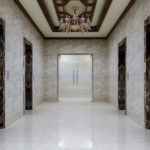As a follow-up to last week’s post about security mesh/screens, Patrick Fiel has given me permission to print his article as a guest blog post. This article first appeared in Security Info Watch.
Security screens provide additional layer of protection for K-12 entries
BY PATRICK FIEL, SR. CREATED: JULY 14, 2014
Expert says screens offer some advantages over traditional window film
Windows and glass doors are among the most vulnerable access points in a school. Criminals can break glass to climb through or reach in and unlock the entry. The security industry has responded with two solutions to slow down a
criminal looking to break into a school building.

Security screens like the ones seen on these windows make it nearly impossible for an intruder to shoot their way into a school building.
One solution is window film that’s applied directly to glass to make it more difficult to break. This product has been on the market for years, but now is available with up to 42 micro-layers of strong, tear-resistant safety film. These films can significantly slow a criminal armed with a hammer or other heavy tool from breaking through glass. As an added benefit, window film is designed to hold onto broken glass reducing the possibility of injury or damage caused by flying glass shards.
Glass on thousands of K-12 facilities is now protected with window film. Anything that delays a criminal from gaining access to his target is a good thing, but that doesn’t make it the best choice for every situation.
Active shooters rarely carry hammers in their arsenals. High-powered handguns, assault rifles and specialty ammunition are usually a shooters’ standard choice of weapons. These weapons are game changers as administrators seek to harden school entries. The front doors at Sandy Hook Elementary were properly locked, but the gunman entered by shooting through an unprotected glass panel. Security film on the glass would have minimally slowed the gunman, who was armed with a Bushmaster semi-automatic rifle.
This video shows how a man armed with a relatively low-powered .38-caliber handgun can shoot through window film, push aside the shattered glass and open a door.
A more secure choice for protecting glass is window screens, which provide an almost impenetrable barrier, capable of withstanding attacks by hammers, knives and even assault rifles. Here’s another video demonstrating the protection offered by security screens.
Security screens don’t stop bullets, but resist further cutting, tearing or blunt force attacks making it almost impossible to create an opening large enough to reach through and unlock a door or window.
Dan Guthrie, owner of Harmony Security Products based in Emigsville, Penn. sells both window film and security screens. He said screens are slightly more expensive, but that the cost difference shrinks as additional doors and windows are added to a job.
“It’s all about creating a physical barrier that prevents intruders from entering a school long enough for first responders to arrive.” Guthrie said. “Security screens are more difficult to penetrate than window film — especially if the intruder is using a high-powered assault rifle. Screens are also more noticeable than film, allowing them to also act as a deterrent.”
Guthrie said screens are available in either stainless steel wire mesh or 18 gauge perforated stainless steel and are attached to doors and windows with tamper-proof screws. Security screens don’t hinder the normal operation of doors and windows and when painted black, screens present a dark, tinted look from the outside, but allow for almost clear vision from inside a school.
Urban schools were the first to adapt security screens, with suburban and rural campuses now beginning to request them, Guthrie said. Colleges and universities also use the screens, particularly on dormitories to help reduce
security incidents.
Admittedly, some people are more comfortable with the film solution, he said. Variations of it are commonly used in residential and commercial locations and automobiles to reduce heat and damage from sunlight. There is also a perception among some that screens make a school resemble a prison. Yet security screens are really just a more robust version of those commonly found on many residential doors and windows.
Security screens don’t have to be placed on all campus windows, but I recommend them for all glass doors and panels. They are also a good choice for windows on remote or temporary classroom facilities where students may have fewer places to hide and find shelter during an attack by an active shooter. The added protection is worth the small premium in price.
Screens aren’t intended to replace other critical layers of security at potential entry points, but rather add another layer of safety. Door and window locks remain critical, as well as video intercoms which enable office staff to remain safely behind locked doors while viewing and talking to visitors before allowing them entry.
When it comes to protecting against an active shooter, it’s all about delaying him from reaching students and staff. Security screens provide a highly effective additional barrier giving first responders more time to respond and take control of an emergency situation.
About the Author: Patrick V. Fiel, Sr., is an independent security consultant and founder of PVF Security Consulting. He has previously served as public safety advisor for a large national security integrator; executive director of security for the Washington, D.C. Public School System; and is retired from the U.S. Army Military Police Corps.
Photo and article courtesy Patrick Fiel, Sr.
You need to login or register to bookmark/favorite this content.





Good article. A question that was brought up in a previous post and is still unanswered is: are any of these security screens listed for use of fire doors? For example, if I wanted to use screens on interior classroom doors off of a corridor, it is likely that these doors would be labeled fire doors. It is my understanding that attaching these screens to the doors with screws would be a code violation unless the screens and attachment methods were specifically approved for such use.
Hi Mike –
You are correct – you can’t install the screens (or film) on a fire door unless it is listed for that purpose. I don’t know if these products can be used on fire doors. If there is more demand for this application, that may drive the necessary testing.
– Lori
Lori,
No one’s ever asked me about applying security screen to a classroom (fire rated) door. We have attached it to non fire rated doors by:
1. Removing the existing fasteners.
2. Drill matching holes in the security screen frame.
3. Re-install the screws in the original holes.
Mechanically the door, frame and fasteners function exactly as designed. With this sight change what test would you guess this configuration might not pass?
Hi Jon –
In order to be applied to a fire door, the screen would have to be listed for that purpose. It’s not so much a question of the installation, but the test would show that the screen doesn’t negatively impact the performance of the door or glazing.
– Lori
It would seem to me that the addition of the screens to fire doors would only increase their effectiveness by maintaining the integrity of the door for a longer period of time. The AHJ or fire marshal could issue special labeling to allow the use of this material. As the father of an elementary teacher I believe there should be no limit for the protection of teachers, administrators, and innocent young children. Government agencies waste millions of dollars annually on unnecessary expenditures when the security of schools should be a top priority.
Hi Leonard –
I agree that we need to do all we can to protect kids and school staff. But I also think we need to follow code requirements or the world will run amok. 🙂
It’s possible that screen or film would not negatively affect the performance of the assembly in a fire test, but it should be tested and listed for that use so all of the i’s are dotted and the t’s are crossed. The other issue with vision lites in classroom doors is that the lite is there for supervision and often required by Board of Education standards, so the screen would have to allow visibility through the lite.
– Lori
Agreed. I know that whatever hardware is on a door when it is fire-tested has to be on the door going forward for certification. Yes, the screen would have to allow visibility to the classroom. When a tragedy like Sandy Hook occurs any decent minded person should be deeply moved to want to put in place measures to prevent any future occurrence if at all possible. Thanks for your very informative site.
One small problem with applying film on existing windows is that the film can create a force on the glass that can and does break it. Commercial building windows that I have found on the Hospital buildings will not warrantee the glass if a film is applied.
Before installing a screen like this on an existing school window be sure that the window is not a required means of egress as required by NFPA 101 15.2.11.1.
Hi Darryl –
If the screen is applied directly to the glass it wouldn’t inhibit egress, but if we’re talking about a security screen installed in conjunction with an operable window, it could be a problem.
– Lori
If anyone has any questions regarding these screens please call 717-767-2779 or check out our website http://www.harmonyspi.com. We are the manufacturer the article was written around.
Thanks Chris!
Hello all. Just wanted to let you know that some of our film, Eversafe Security Film by HanitaTek, meets the following fire codes:
BS 476 Fire Propagation
ASTM D1929 Ignition
ASTM E84 Surface Burn
Feel free to contact me if you have any questions! Great article and comments.
Knowing that the school that my kids go to has these types of screens on the windows makes me feel a whole lot better. Something like this could also be used at home to deter any wanna-be burglars. After watching the two videos that you linked in the article, it really is surprising how much of a difference a good security film can make.
This is an old post, but I wanted to bring up a point:
Many school shootings are committed by students or staff members who already had access to the facility, and someone who has access to the facility can easily defeat security from the inside. Take the case of the Harvey Milk assassination:
https://en.wikipedia.org/wiki/Moscone%E2%80%93Milk_assassinations
Dan White had a ground floor office in the San Francisco city hall. To smuggle in a gun past the front door metal detectors he simply opened his office window, left the building, retrieved the gun, tossed the gun through the window, entered through the front door, went to the office, and retrieved his gun. He then shot Mayor George Moscone and Supervisor Harvey Milk.
A case like that could be prevented by making windows in schools un-openable; but the point is, if the people who have security access turn out to be bad guys, things like security screens may turn out to be useless. You have to take the human approach, and try to make sure that the people in your employ and the students in your care are mentally stable and economically secure, or else you’re only inviting tragedy.
I agree – the “bad guy” is often authorized to be inside. It’s not easy to find the right balance.
– Lori
I think that its really cool that they have developed a thin film that can make it so much harder for some body to break a window or any glass. I definitely want to get some of that film for the windows on my car. I feel like it would make car crashes safer, because of how the film holds the glass together when broken.
The technology is quite wonderful. But if we have to install security screens and windows in our schools to protect our children, what does that say about our current society in general?
I love how you said that security screens prevent big wholes and tears that can happen if someone tries breaking in. Parents should consider getting these installed on their windows and doors in order to fully protect their kids from danger while at home. Thanks for helping people see the security benefits of having screen doors.